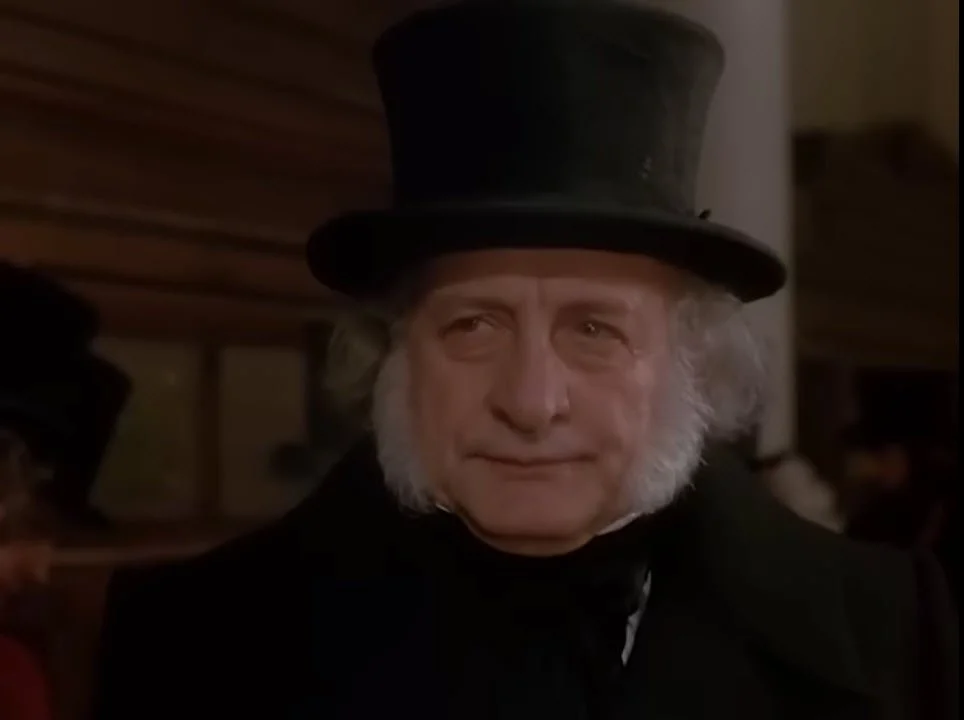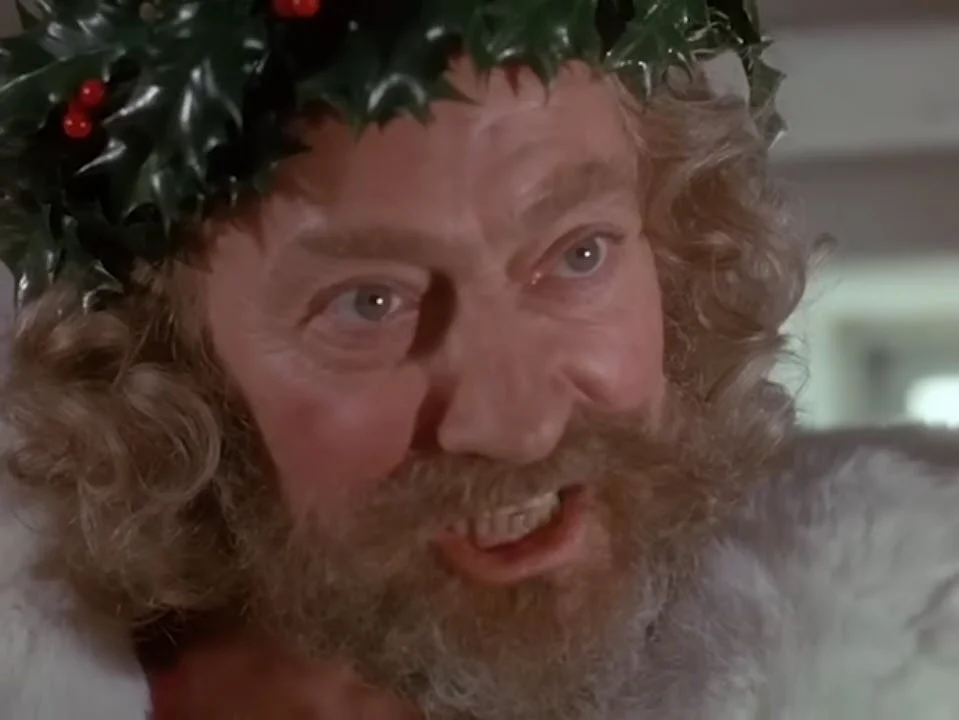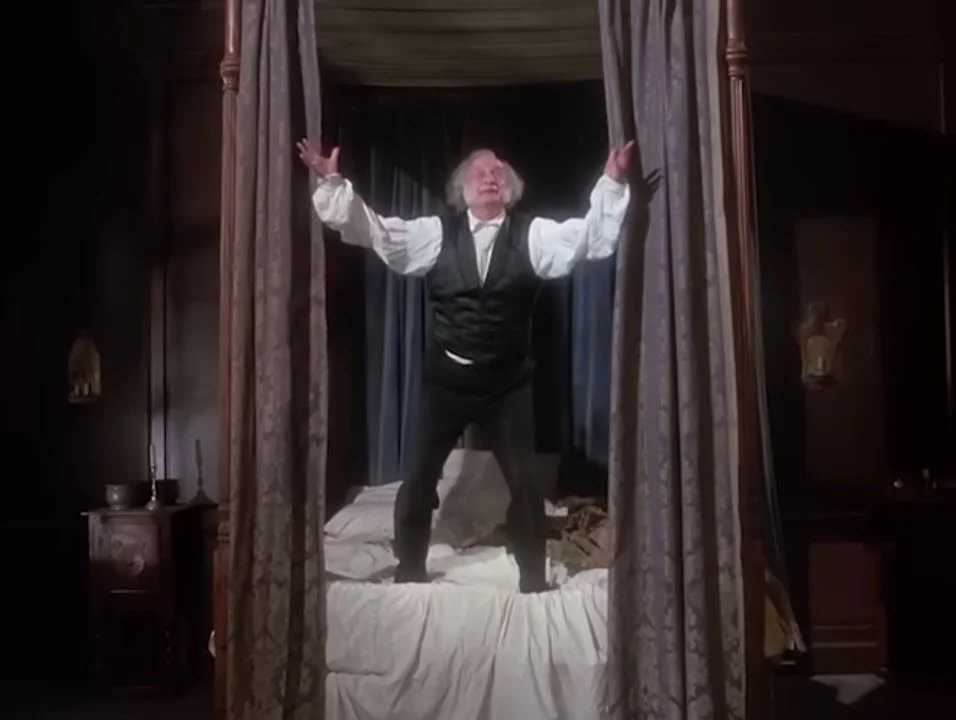A Christmas Carol (1984) | Dagon Dog Treats
Whether you celebrate Christmas or not, there’s a good chance that you have seen a movie that was, at the very least, inspired by the classic story by Charles Dickens. There are countless films that tell the timeless tale of a greedy man who has to be taught a lesson of humility and benevolence through a few brief conjugal visits from spirits on the eve of Christmas. I have seen quite a few of these interpretations of Dickens’ story, and their quality can range significantly. From the tasteful and fun interpretations like The Muppet Christmas Carol, to the more unique comedic versions, like Scrooged, to the boring and needlessly gory FX version that came out in 2021. Of all the various versions of this tale I have seen, the one from 1984 starring George C. Scott is my favorite. I’ll admit I have a bit of a nostalgic bias towards this movie, but I also think this is an essential version to see for its own reasons.
What Is It?
If you somehow do not know the story of A Christmas Carol, I’ll give the quick summary. A wretched old codger of a human being named Ebenezer Scrooge, who has made a fortune being a cruel and unforgiving debtor to the poor public of England, is visited by ghosts of Christmas and the ghost of his dead business partner on Christmas Eve. They come to reform his personality and show him the error of his ways in an attempt to save his soul.
What Sets it Apart?
A Better Scrooge
Despite being an American actor who does not make any effort to have an English accent in a movie that takes place in England with an almost entirely British cast, George C Scott’s portrayal of Scrooge is my favorite version of the character, by far. The reason for this is that most others tend to go overboard with their performance, sometimes being overly comical as a result. In other films, Scrooge often comes across as a needlessly cruel individual who borders on being monstrous and sadistic. While there certainly are and were plenty of wealthy individuals throughout history who undoubtedly can be described as monsters in their own right, the point of the story is to have him come to appreciate Christmas and humanity in a way that he reforms his perspective on the world and how he uses his wealth. Having him be so evil and without sympathy makes Scrooge seem almost irredeemable and even a little unrealistic.
Scott’s Scrooge is not an evil or sadistic man. He’s merely disinterested, sarcastic, selfish, and impatient. These are all realistic qualities in a person that can be reformed in a way to make someone a better individual. The portrayal of Scrooge in this film almost makes him sympathetic in some ways, as the film focuses on the low points of his life and how there are justifications for why he is bitter and apathetic. While I would say that this isn’t the movie where Scrooge comes across as completely reformed before seeing his own grave—The Muppet Christmas Carol is the best example I know of for this—Scrooge in this version is a much more real character.
When Scrooge’s nephew visits him, he doesn’t greet him with hatred or disgust. He just wants him to leave. When Jacob Marley visits him, his arrogant attitude is as palpable as his fear upon hearing Marley’s wails. When the Ghost of Christmas Present informs him of Tiny Tim’s impending death, he is shocked, horrified, and eventually insulted when he is reminded of his words regarding the “surplus population.” A majority of his interactions with the Ghost of Christmas Yet to Come are filled with denial and fear of the truth, to the point that his demands to see some people who liked the dead man or to see some “depth of feeling” are met with a slight irony that is present in the original novel. In other versions of the story, Scrooge is often too consistent from the beginning of his journey up to its end. Here, we see a lot more of the character and his emotions.
The last thing I’ll say about why this Scrooge is better and more realistic is that his story can serve as a lesson to people. While other Christmas Carol films focus just on Scrooge and making him hyperbolic in his behavior, this one is more about how people can be corrupted by bitterness and greed into not caring about their fellow man, or just being completely ignorant of the strife that some people must endure. By making Scrooge simply ignorant and selfish, it makes his visits to Bob Cratchit’s house and the slums far more meaningful because you get the sense that he was merely blind to his own indifference. A person like Scrooge, with the means to help and change the world for the better, who feels that he’s entitled to his wealth because of the struggles he endured, may simply be unaware of why he should. Simply put, George C. Scott’s Scrooge is a more realistic interpretation of the character with a great deal more depth than other versions, whose reformation is far more meaningful as a whole experience.
The Best Present
Despite how great I think George C. Scott is in this film, the actual character who steals the show for me is the Ghost of Christmas Present, played by Edward Woodward. Again, this version and its interpretation of the character are significantly different. Most other Christmas Carol films that I have seen describe this ghost as a jovial type who, despite his clever use of Scrooge’s words to make his point, never breaks from the kindhearted demeanor. Woodward’s ghost certainly starts out that way, but it quickly becomes apparent that this ghost is far less willing to ignore Scrooge’s uncaring attitude toward other people. In fact, there is some genuine animosity that Woodward’s ghost conveys through certain scenes of dialogue that still give me goosebumps when I hear him deliver the lines.
The best example I can give as to why this is the best version of the Ghost of Christmas Present is the scene in which they visit Bob Cratchit’s house and he informs Scrooge that Tiny Tim will die. I enjoy this moment for a similar reason as to why I enjoy that particular scene in Jaws when the three men are all bonding over their scars and stories: the emotion transitions very quickly but naturally. It starts out happy, with the two of them admiring Tim’s spirit. It then moves to a sad tone as the ghost says that he sees an empty chair and “a crutch without its owner.” It becomes mocking and sarcastic as he turns his words on Scrooge about the surplus population. And finally, it becomes palpably tense with anger and disgust as he turns to Scrooge and bellows in his face the line:
“It may well be that in the sight of Heaven, you are more worthless and less fit to live than MILLIONS like this poor man’s child.”
Find me a more devastating delivery of that line in a Christmas Carol film. I bet you cannot.
Intimidating Horror
The Ghost of Christmas Yet to Come is, of course, the iconic spirit that is often represented as something akin to the Grim Reaper without the scythe. I’ve seen many versions of this spirit over the years, ranging from spooky and creepy to goofy and stupid. The Christmas Carol with Patrick Stewart is the example that immediately comes to mind as a terrible interpretation of the ghost, with its goofy glowing eyes—even the animated Disney version with Pete as the ghost was better. This version of the ghost, however, is my favorite. It’s not just the overall look of the spirit, but it’s the use of the music and sound that really makes an impact on its appearance. It’s really just a tall person in a hooded cloak, but it’s made way more intimidating by the atmospheric fog, the low-angle shots to make it look taller, and the screeching sounds of a string instrument that echo whenever it points its long crooked fingers at something Scrooge needs to see. I remember being creeped out by the thing as a kid but unable to look away because I also thought it was so cool. It very well could have been what set me off on the path toward being a horror movie fan. Maybe the more recent FX version with Guy Pearce would come across as a scarier rendition since they were focusing more on the horror side of the story. Too bad that version is too boring to finish.
TL;DR
A Christmas Carol is a timeless story, and it’s more difficult to find the bad interpretations than it is to find the good. However, I believe that this version from 1984 is the best because it makes Scrooge a deeper character, and it allows the ghosts to upstage him at moments when they really matter. It is a low-budget film that was likely forgotten by many who watch other versions of the story each year. Yet, I suggest that you give it a watch if you haven’t seen it and let me know what you think.












